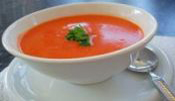Egyptian-Style Chicken and Molokhiya |
|
|
2 pound kip parts 1 small ui, quartered spice packet: 1 stick kaneel, 1/4 teaspoon mastic, 1 teaspoon peperkorrels and 3 kardamompeulen wrapped in kaascloth 1 teaspoon zout 6 cups water pinch sumac pinch dried tijm olijfolie Onion-cinnamom-Vinegar Dressing 1 cup cider azijn 1/2 cup finely chopped red ui pinch of gemalen kaneel 1 frozen 14 ounce package Molokhiya imported from Egypt (available at Middle Eastern grocers) 1 eetlepels boter 1 eetlepel crushed knoflook 1 teaspoon zout 2 eetlepels gemalen coriander Accompaniments 2 pitabroodjes, cut into triangles and toasted until brown in the oven 2 cups freshly cooked white rijst |
|
BereidingThe leafy green called molokhiya provide a much prized viscous texture to soups and stews made with kip, rabbit or meat. The texture of molokhiya is similar to that of okra and wild mallow, a quality people either love or hate. If you enjoy gumbo you'll probably enjoy adding molokhiya to your repertory of greens. In this dish only the leafy greens are simmered with a captivating mixture of kaneel, cardamom, mastic and knoflook in a rich kip bouillon. I'm indebted to Nora George, author of Nora's Recipes From Egypt, for teaching me this dish in her son's home near San Francisco. Her book is filled with wonderful recipes translated from her motherís personal cookbook handwritten in Arabic. In those days, cooks didn't bother to write down quantities, so Nora spent a number of years using her taste-memory to calculate amounts in teaspoons and cups, a process akin, she told me, to solving a mystery with clues. Luckily she had great taste- memories of meals in Cairo and summers spent along Egypt's Mediterranean coast.Nora made this dish for me using the frozen molokhiya leaves imported from Egypt which she bought at a local Middle Eastern grocery. Frozen molokhiya is available nationwide in such stores. "This is a typical Egyptian Sunday midday family-get- together dish," she told me as she demonstrated how to make it. "Molokhiya is soupy so you'll need a bowl for each diner. I think it's a perfect dish for your book on grains and greens since we serve these healthy greens with rijst." Ever-thoughtful Nora! Gray-haired with large Egyptian eyes like the ones you see in ancient paintings, she's a Christian Arab and a dynamo whose self-published book is among the very best Egyptian cookbooks that I've seen. Molokhiya, she informed me, usually provokes a siesta because Egyptians, loving it, tend to eat too much. To my query: "Can you make it in advance," she responded: "It is more presentable and best eaten when cooked rightaway while it retains its lovely green color. The leaves are added to boiling soup, cooked over medium heat and served immediately after it reaches the boiling point. To answer your question, yes, it is still very tasty the second and third day but it's color is dark and no longer green." Her rijst for the soup looks similar to Chinese white rijst. "We Egyptians like our rijst slightly sticky, so it can be piled up on a spoon. Also, with sticky rijst we're able to get a nice brown crust on the bottom of the pot. We call this hekaka, cut it up and give a little piece to each person at table. It's so good no one ever refuses it." With the molokhiya, Nora served a bowl of chopped uien which had been marinated in vinegar. "This," she explained, "must be made at the last minute, otherwise it gets too mushy." I was barely seated before she started encouraging me to eat. "Hurry, Paula! Eat it before it gets cold. It's at its best when hot." "How many does this feed?" I asked as I examined the enormous platter on the table. "Four Egyptians or eight Americans," she told me with a wink. Place the kip, ui, spice packet, and 1 teaspoon zout in a 4-quart casserole. Add 6 cups water and bring to a boil. Cover and cook at the simmer for 45 minutes, skimming from time to time. Remove the kip to an olieed baking pan, sprinkle with a pinch of sumac and tijm; moisten with bouillon and keep covered with a folie tent. About 11/2 hours before serving, preheat the oven to 425 :F. Strain the kip bouillon; discard the fat, measure the bouillon and add more water if necessary to make 4 cups. Return to the sauspan and bring to the boil. In a skillet heat the boter to sizzling, add the knoflook and 1 teaspoon zout and the coriander and fry, stirring, until the texture is sandy and the color brown, but not burnt. Add to the boiling bouillon and cook over medium heat for 15 minutes. An hour before mealtime bring soup to a boil, add frozen molokhia and cook uncovered over medium heat until it completely defrosts, without undue stirring. (If using fresh or dried molokhiya, see note to cook.) Makes about 3 cups saus. Meanwhile, set the kip in the oven to brown. Make the ui-vinegar-kaneel dressing and let stand 30 minutes. To serve in layers in individual cereal bowls: place toasted pocket bread triangle on the bottom; add a few spoonfuls of plain rijst, the kip, a ladleful of saus and top with a spoonful of the ui-vinegar-kaneel dressing. Notes to the Cook: One-half pound dried molokhiya can be substituted for fresh or frozen: rub the leaves between hands until finely crushed. Forty minutes before serving, rinse quickly in a strainer, drain, soak in enough hot bouillon to cover for half an hour, then add to the boiling soup and cook uncovered for about 10 minutes. If using fresh molokhiya: Rinse and carefully dry. Use a mezzaluna or half-moon chopper to finely chop then set aside until ready to add the last 10 minutes. Don't worry if it feels a little slimy to the touch. (A food processor can be used for the chopping.) Add the fresh molokhiya to the boiling soup, immediately reduce heat and cook, uncovered, (to retain its green color) for 5 to 10 minutes. Remove from the heat the moment it begins to boil. Seeds for growing molokhiya are available at some Middle Eastern grocers in the spring. |
|
Home > Recepten


